Top 10 Vacation Destinations in Alaska
When it comes to vacation, Alaska is an incredible destination. From its stunning glaciers and wildlife-filled forests to its picturesque mountain ranges and cosmopolitan cities, the 49th state has something for everyone. If you’re looking to plan a memorable getaway, these Top 10 Vacation Destinations in Alaska are guaranteed to be the best of the best.
There are so many things that make Alaska unique. The name Alaska comes from the Unangax word alaxsxa or alaxsxix, which means “mainland” or “great land.” The mainland includes about 15,000 square miles with about 34,000 miles of tidal coastline including fjords and inlets. The Alaska Peninsula is the largest peninsula in the Western Hemisphere. However, since the 180th meridian passes through the state’s Aleutian Islands, it is actually also in the Eastern Hemisphere. This state is surrounded by seven bodies of water, The Beaufort Sea and the Arctic Ocean to the north, the Gulf of Alaska and the Pacific Ocean to the south, the Bering Strait and the Bering Sea to the west, and the Chukchi Sea to the northwest. This amazing state is part of great circle route that connects North America wit Asia by sea and air, which has made it militarily significant since the Japanese invasion in 1942 during WWII. This great state has more than 130 active volcanoes and has one of Earth’s most active earthquake belts as well. Alaska continues to be the United States last frontier.
-
Denali National Park and Preserve
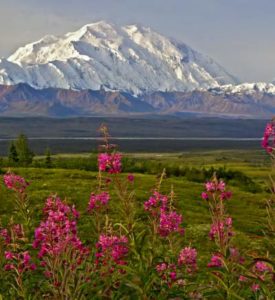 Coming in at number 1 in our Top 10 Vacation Locations in Alaska is Denali National Park and Preserve, home of North America’s highest peak, Mt McKinley. Here you’ll witness breathtaking views of wildflower meadows, glacial valleys, alpine tundra, and rugged mountain peaks on six million acres of land, bisected by one road where wild animals roam un-fenced living as they have for ages.
Coming in at number 1 in our Top 10 Vacation Locations in Alaska is Denali National Park and Preserve, home of North America’s highest peak, Mt McKinley. Here you’ll witness breathtaking views of wildflower meadows, glacial valleys, alpine tundra, and rugged mountain peaks on six million acres of land, bisected by one road where wild animals roam un-fenced living as they have for ages.
Little Known Fact: Scientists have documented 39 species of mammals in Denali, but it is the five largest mammals that capture visitors’ imaginations: moose, caribou, Dall sheep, wolves and grizzly bears. Visitors can also see 169 species of birds and over 1,500 species of plants.
-
Katmai National Park and Preserve
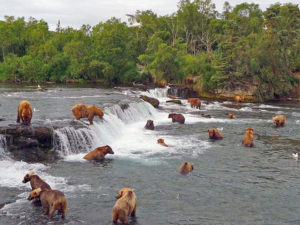 Ranking at number 3 on our Top 10 Vacation Locations in Alaska is Katmai National Park and Preserve protects 9,000 years of human history. It is an important habitat for salmon and brown bears. Katmai was established in 1918.
Ranking at number 3 on our Top 10 Vacation Locations in Alaska is Katmai National Park and Preserve protects 9,000 years of human history. It is an important habitat for salmon and brown bears. Katmai was established in 1918.
Little Known Fact: Katmai Collapsed. By midnight of the first day, 11 hours into the eruption, enough magma had escaped from beneath Mount Katmai that about 1.2 cubic miles of its summit collapsed. The collapse resulted in a 1.5-mile-wide caldera, which has since accumulated in a lake about 800 feet deep.
-
Homer
 Homer comes in at number three on our Top 10 Vacation Locations in Alaska. For a unique experience, take a boat tour around the Kenai Fjords National Park to get up close and personal with humpback whales, porpoises, and sea otters. This charming seaside town offers natural beauty, vibrant culture and warm hospitality. You’ll find museums, art galleries, and local artisans.
Homer comes in at number three on our Top 10 Vacation Locations in Alaska. For a unique experience, take a boat tour around the Kenai Fjords National Park to get up close and personal with humpback whales, porpoises, and sea otters. This charming seaside town offers natural beauty, vibrant culture and warm hospitality. You’ll find museums, art galleries, and local artisans.
Little Known Fact: Homer, Alaska is known as the Halibut Fishing Capital of Alaska. It is also known for having the 2nd longest Spit in the World. “The Spit” is a piece of land that sticks out into the water. The Homer Spit is 5 miles long.
-
Juneau
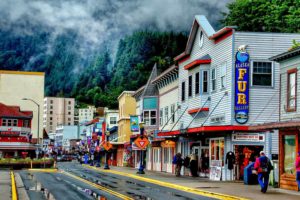 Juneau is our number four destination on our Top 10 Vacation Locations in Alaska, where you can explore the capital city’s many historical sites and cultural attractions such as Mendenhall Glacier and Mount Roberts Tramway. Here you can spend time viewing wildlife, take the fishing trip of a lifetime, explore glacier, or wander the city’s shops, restaurants, and artistic offerings.
Juneau is our number four destination on our Top 10 Vacation Locations in Alaska, where you can explore the capital city’s many historical sites and cultural attractions such as Mendenhall Glacier and Mount Roberts Tramway. Here you can spend time viewing wildlife, take the fishing trip of a lifetime, explore glacier, or wander the city’s shops, restaurants, and artistic offerings.
Little Known Fact: Juneau, Alaska, has been renamed twice. A mining camp formed, and within a year, it became a small town called Harrisburg. That name was soon changed to honor the naval lieutenant commander stationed there, Charles Rockwell. In 1881, the miners changed the town’s name again, this time to honor Juneau.
-
Chugach State Park
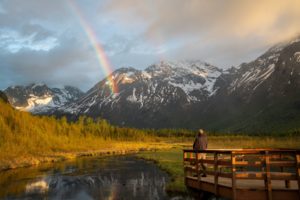 Coming in at number 5 in our Top 10 Vacation Locations in Alaska is Chugach State Park to experience nature at its finest. The park is made up of about 495,000 acres of land located in Southcentral Alaska. It’s situated between the Alaska Range, Chugach and Wrangel Mountains, and Prince William Sound. It has an extensive ocean shoreline, abundant lakes, massive glaciers, and ice fields.
Coming in at number 5 in our Top 10 Vacation Locations in Alaska is Chugach State Park to experience nature at its finest. The park is made up of about 495,000 acres of land located in Southcentral Alaska. It’s situated between the Alaska Range, Chugach and Wrangel Mountains, and Prince William Sound. It has an extensive ocean shoreline, abundant lakes, massive glaciers, and ice fields.
Little Known Fact: Encompassing almost a half a million acres in Southcentral Alaska, this wildlife-rich park is one of the four largest state parks in the United States.
-
Fairbanks
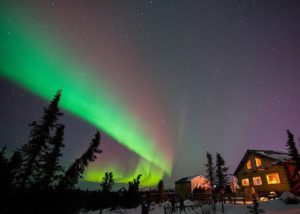 Make your way to Fairbanks, our number six destination on our Top 10 Vacation Locations in Alaska, for incredible views of the aurora borealis in the winter months, as well as outstanding recreational opportunities such as fishing on Chena River or gold panning in Fox. Fairbanks boasts beautiful mountain ranges, pristine rivers and lakes, abundant wildlife, and poignant solitude.
Make your way to Fairbanks, our number six destination on our Top 10 Vacation Locations in Alaska, for incredible views of the aurora borealis in the winter months, as well as outstanding recreational opportunities such as fishing on Chena River or gold panning in Fox. Fairbanks boasts beautiful mountain ranges, pristine rivers and lakes, abundant wildlife, and poignant solitude.
Little Known Fact: Fairbanks is also the only place in Alaska where a tornado has ever been recorded. The hottest temperature ever recorded in Fairbanks was 99°F in 1919. The coldest temperature ever was -66°F in 1934. On average, Fairbanks is one of the coldest cities in the U.S. with average winter low temperatures from -15°F to -25°F.
-
Skagway
 Be sure to take in Skagway, our number seven spot on our Top 10 Vacation Locations in Alaska, where you can explore historic downtown or take part in adventure activities such as white water rafting or ziplining. The population is 1,240 in 2020 but doubles in the summer tourist season in order to deal with more than 1,000,000 visitors every year. It was previously a city and is now incorporated as a borough.
Be sure to take in Skagway, our number seven spot on our Top 10 Vacation Locations in Alaska, where you can explore historic downtown or take part in adventure activities such as white water rafting or ziplining. The population is 1,240 in 2020 but doubles in the summer tourist season in order to deal with more than 1,000,000 visitors every year. It was previously a city and is now incorporated as a borough.
Little Known Fact: Skagway is known as the “sunshine capital” of southeast Alaska, receiving just 27 inches of precipitation a year. The year-round population of Skagway is 920 residents, which more than doubles in the summer. During the gold rush, Skagway boasted a population of 12,000.
-
Ketchikan
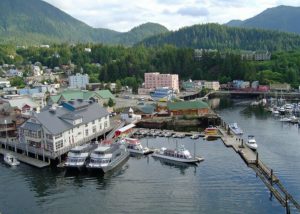 For something truly off-the-beaten-path, head southeast to Ketchikan, ranking at number eight on our Top 10 Vacation Locations in Alaska, a charming fishing village with unique shops and galleries. It is set at the southernmost entrance to Alaska’s famed Inside Passage—a network of waterways that snake through some of the most beautiful wilderness in the world. Ketchikan is best known for three things: feisty salmon, idyllic scenery, and a rich Alaska Native culture.
For something truly off-the-beaten-path, head southeast to Ketchikan, ranking at number eight on our Top 10 Vacation Locations in Alaska, a charming fishing village with unique shops and galleries. It is set at the southernmost entrance to Alaska’s famed Inside Passage—a network of waterways that snake through some of the most beautiful wilderness in the world. Ketchikan is best known for three things: feisty salmon, idyllic scenery, and a rich Alaska Native culture.
Little Known Fact: Ketchikan is named after the creek that runs through town. The name “Ketchikan” comes from the Tlingit name for the creek, Kitschk-hin. Ketchikan Creek is a productive habitat for salmon. Cape Fox Tlingit Alaska Native peoples came to the area that would become Ketchikan for centuries to fish the waterway.
-
Anchorage
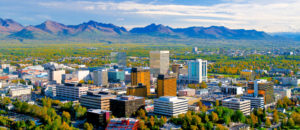 Further down the coastline you’ll find Anchorage, Alaska’s largest city with a population of 291,247 in 2020, accounting for almost 40% of the state’s population. It’s our number nine pick in our Top 10 Vacation Locations in Alaska. Explore the city’s museums or visit nearby places like Eklutna Lake. This city combines Alaskan beauty with urban comforts all in one place.
Further down the coastline you’ll find Anchorage, Alaska’s largest city with a population of 291,247 in 2020, accounting for almost 40% of the state’s population. It’s our number nine pick in our Top 10 Vacation Locations in Alaska. Explore the city’s museums or visit nearby places like Eklutna Lake. This city combines Alaskan beauty with urban comforts all in one place.
Little Known Fact: The city can get 22 hours of daylight on summer solstice, the sun barely squeaks below the horizon; streetlights don’t come on. Anchorage makes the most of that light, hosting a summer celebration downtown.
-
Utqiagvik
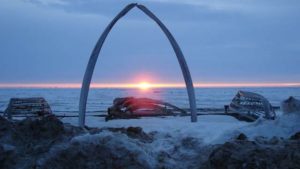 Finally, our number ten ranked destination on our Top 10 Vacation Locations in Alaska, takes you north to Utquagvik, formerly known as Barrow, situated at the northernmost tip of Alaska. It’s one of the largest Iñupiat settlements in Alaska. Here you’ll witness 24-hours of daylight during summer months and learn about local Arctic cultures through fascinating sites like the Iñupiat Heritage Center. It’s the northernmost community in the United States.
Finally, our number ten ranked destination on our Top 10 Vacation Locations in Alaska, takes you north to Utquagvik, formerly known as Barrow, situated at the northernmost tip of Alaska. It’s one of the largest Iñupiat settlements in Alaska. Here you’ll witness 24-hours of daylight during summer months and learn about local Arctic cultures through fascinating sites like the Iñupiat Heritage Center. It’s the northernmost community in the United States.
Little Known Fact: Recently changed the name from Barrow to Utqiagvik. Located on the Arctic Ocean, is one of the largest Iñupiaq settlements in Alaska. It’s also the northernmost community in the United States. Its extreme location means Utqiaġvik receives 24-hour daylight from May 10 – August 2 and 24-hour darkness from November 18 – January 23.
Q&A to Help
Can you drive to Alaska from the United States? is a common question among travel enthusiasts. As someone who has driven there and back, I can say that it’s totally possible. In fact, people from all across the US except Hawaii can drive to this beautiful state through the Alaska Highway.
How long is it dark in Alaska? With 24-hour daylight during the summer months and 24-hour darkness during the winter, many people find Alaska to be a strange and mysterious place. Here are some debunked myths about the unusual daylight patterns of Alaska.
Do I need a passport to go to Alaska? U.S. citizens flying between another state and Alaska do not need a passport. However, those driving through Canada or traveling on a ferry or cruise ship with stops in Canada are required to carry one.
Is it expensive living in Alaska? Average Cost of Living in Alaska: $54,331 per year. Data gathered by MERIC 2022 ranked Alaska as the state with the sixth highest cost of living.
How warm does it get in Alaska? By July, daytime temperatures in the Interior can average in the 70° F range—although it has been known to reach well into the 90s—while temperatures in the coastal areas and higher elevations rarely get above 65° F.
How cold does it get in Alaska? Winter temperatures in Alaska range from 0°F / -18°C to -30°F / -35°C from November to March. Finally, while it can rain throughout Alaska’s summer, May is often the driest month in Alaska, and September is typically the wettest.
Does Alaska have 3 time zones? Alaska • Time zones: Hawaii-Aleutian time and Alaska time • Alaska used to have four time zones. In 1983, however, the government consolidated the time zones to two: Hawaii-Aleutian time, which applies to the westernmost Aleutian Islands, and Alaska time for the rest of the state.
Can you take Amtrak to Alaska? You can’t get to Alaska by train, but you can get close. From the west coast of the U.S., you can take Amtrak’s Cascades to Bellingham, Washington; the dock for the Alaska ferry is quite close to the railroad station.
How much does it cost to see the northern lights in Alaska? Fairbanks Northern Lights tour prices range from $185 to $310 or more.
Do you get $1000 for living in Alaska? In the past, citizens have qualified for up to $1,600 for simply living in Alaska, and in 2022 the amount was $3,284. All you have to do to receive this grant is to remain in the state for an entire dividend year!
What is the hottest month in Alaska? Winter in Alaska may be cold, but the snow-draped scenes and Northern Lights are spectacular. However, if you prefer warmer weather adventures, then visiting Alaska in July will suit you best. It’s the hottest month of the year, with a daily average temperature that sits around 67 °F.
What is the coldest month in Alaska? In general, however, the climate is bearable, with an average in January (the coldest month) of 14° F.
Does it snow a lot in Alaska? Winter is the most extended season in Alaska. Snowfall varies significantly, and some mountainous regions receive 1000 inches annually. Winter is a magical time of year; to live in Alaska and enjoy it, you need to like winter.
Does it rain a lot in Alaska? While Alaska is one of the drier states overall, in Ketchikan you’re looking at an average annual rainfall of between 140 and 160 inches per year. Precipitation comes fairly evenly throughout the year, with more during the fall and winter months.
What is Alaska known for? The Iditarod, gold mining, sourdough, the Alaska Railroad, aviation, Alaska Native heritage, homesteading, world-class fishing and seafood, outdoor adventures, fresh air, and a slower, more self-sufficient way of life.
What month is the best to go to Alaska? The best time to visit Alaska is between mid-June and mid-September. The warmer weather and long days make this a particularly pleasant time of year, with temperatures in the cool-but-comfortable range of 60 to 67°F.
How long is the ferry ride from Seattle to Alaska? The barge trip from Seattle to Fairbanks takes about 2 weeks and from Fairbanks to Seattle takes between 19 & 21 days depending on weather.
How long is the drive from Seattle to Alaska? The road trip for the Direct Route is 2,260 miles and takes about 41 hours, the Scenic Route is 2,590 miles lasting about 46 hours.
What month is best to see northern lights in Alaska? The best time to see the northern lights in Alaska is between August and April, when less daylight leads to darker night skies.
Do the northern lights happen every night in Alaska? You may be surprised to find out that Alaska is the only place in North America where the northern lights happen every day.
Each of these Top 10 Vacation Locations in Alaska offer something special for travelers who are looking for an unforgettable experience. Whether it’s taking breathtaking hikes around Denali National Park, exploring Anchorage’s urban offerings, or learning about Arctic culture in Barrow – Alaska is sure to exceed all expectations and provide an eye-opening adventure that will never be forgotten. What are you waiting for? Head North to Alaska for a vacation unlike any other!
